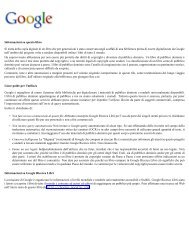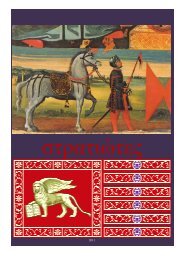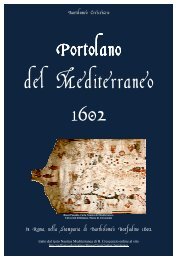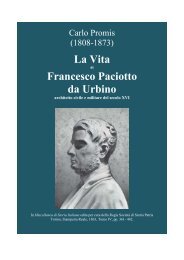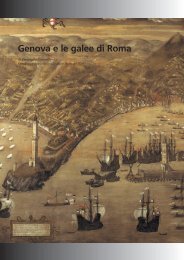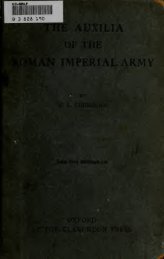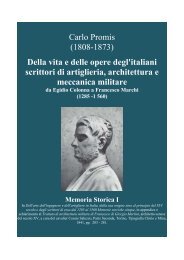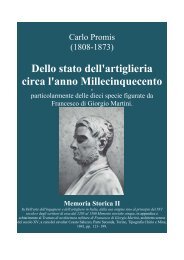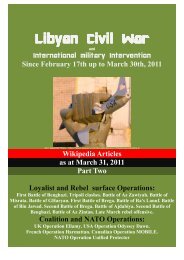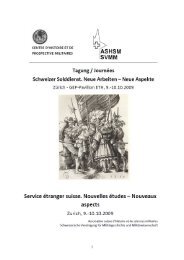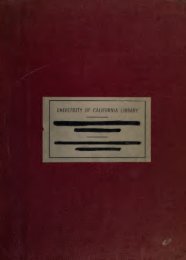78 SMITHSONIAN STUDIES IN HISTORY AND TECHNOLOGYEdmund R. Lyon of Philadelphia for 2000 capsand the next cost of clothing list carries them at acost of $2.78 to the soldier.'" A total of 6158 werepurchased during fiscal year 1877, and 6250 wereissued.'" Almost immediately the seal skin wasfound to become brittle after being wet and followinga short trial a switch to a model of muskratskin was made."* Specifications were drawn and thefirst contract was let with Edward S. Mawson SzSon of Philadelphia on 14 September 1878 for2500 at $.841/^ each.'^'WARDEPARTMENT,QUARTERMASTER GENERAL'S OFFICE.the sealed standard sample adopted this date.Adopted April 17, 1884.S. B. HOLABIRD,Quartermaster-General, U.S.A.In 1886 a scarlet wool lining was substituted forthe 'cotton jean" in the interest of warmth."* Beyondthis there was no significant change. Thenext year the Secretary of War approved the issueof fur caps in place of canvas whenever requisitioned."'Thenceforward the fur cap gradually replacedthe canvas and in <strong>1902</strong> was comprehensivelydescribed.'*'Specifications for MuskratCaps.To be made according to standard sample, of muskratskin, with ear-flaps, cape, and visor, according to pattern.Lining of brown chintz or silesia, padded with cottonwadding.Sizes same as for dress and forage caps.Adopted March 12, 1879.M. C. MEIGS,Quartermaster General,Bvt. Major General, U.S.A."'This model was successful and appreciable numberswere procured and issued during the nextfew years.'"In 1884, in an economy move, caps made of surplustentage, waterproof, dyed brown, and linedwith heavy blanket material were substituted forthe fur caps. These were made up at clothing depotsand issued gratuitously with the same stipulationsregarding geographical area as in the caseof the fur models (Figure 56). They were consideredwarmer than those of fur."^WAR DEPARTMENT,QUARTERMASTER-GENERAL'SOFFICE.SPECIFICATIONS FOR CANVAS CAPS.Material.—To be made of 6-ounce cotton duck, dyedbrown, lined with light blanket cloth next the duck, andwith light-colored cotton jean in the inside; to have twobuttons on the cape to button at the throat, and one vestsize, brown "lasting" button on the top for finish. The visorand edges bound with ^4 brown cotton tape.Style.—Scull cap with extension, forming a cape reachingto the shoulders and meeting in front, covering the throat,and buttoning together with two buttons. A visor of thesame material bound with ^ brown cotton tape sewed onthe forehead (to be worn up or down as desired), and havinghook and eye to fasten it when turned up.Workmanship.—To be cut and made in conformity withA, CANVAf.lVMvwWC, Cotl-on JIAN.FIGURE 56.—Canvas winter cap, model 1884. (Drawingfrom QM Specification No. 109, 17 April 1884, RG 92 NA.)
NUMBER 30 79WAR DEPARTMENT,QUARTERMASTER GENERAL'S OFFICE.specifications for Muskrat Fur Caps.Material.—Fur portion to be of full furred and seasonedtrapped muskrat skins (winter or spring skins only), thoroughlydressed with butter or oleomargarine, and cleanedwith white or yellow sawdust (no alum or vitriol or otherchemicals to be used), each skin to be sufficiently large toadmit of the half crown being cut in one solid piece, exceptone small additional piece is allowed at each side to makerequired width. The lining to be of good quality brownsateen, counting about one hundred and twenty (120)threads to the inch of warp and two hundred (200) threadsto the inch of filling, sustaining a tensile strength of not lessthan thirty-six (36) pounds both in the warp and the filHng;the sateen weighing about two and one-fourth (2 ^) ouncesto the linear yard, thirty-six (36) inches wide. Interliningof good quality cotton wadding in the body of the cap, withan interlining in the cape and ear-laps of furniture haircloth, medium weight, as shown in the sealed standardsample, counting about sixty-two (62) threads to the warpand forty-two (42) threads to the filling.Measurements.—Height of crown to be about seven (7)inches on the pelt, full in the circular slant, as shown in thesealed standard sample. The greatest depth of the ear-lapsto be about five (5) inches, continuing around the cap,forming in the back a cape of about three (3) inches, witha visor in the front, properly shaded, its greatest depth beingabout two and three-fourths (2^) inches; the fur composingthis section of the cap embodying no more piecing ofthe fur than is shown in the sealed standard sample. At thetop of each ear-lap a black tape string about nine (9) incheslong and one-half (Y2) inch wide for the purpose of extendingover the crown of the cap and tying to hold theear-laps and capes in position. The lining and interliningof the body of the cap to be quilted in block pattern, asshown in the sealed standard sample, not less than twelve(12) stitches to the inch; the joining of the body of thecap to the lining thus prepared to be neatly and securelysewed with about six (6) stitches to the inch. The ear-lapand cape to have an interlining of furniture hair cloth togive that portion of the cap stability, and applied as shownin the sealed standard sample.The above measurements and descriptions based on sizeseven and one-eighth (7^), all other sizes to be in proportion.To be like and equal the standard sample in everyparticular.Adopted August 25, <strong>1902</strong>, in lieu of specifications ofMarch 12, 1879 (No. 6), which are canceled.M. I. LUDINGTON,Quartermaster General, U.S. <strong>Army</strong>.THE INDIAN SCOUT CAMPAIGN HATIn 1866 the Congress in reestablishing the peacetime<strong>Army</strong> authorized the President "to enlist andemploy in the Territories and Indian country aforce of Indians, not to exceed 1000, to act asscouts, who shall receive the pay and allowancesof cavalry soldiers, and to be discharged wheneverthe necessity for their employment is abated . . . ."""As of October 1868 there were 412 such scouts inthe service.'*' Over the years these scouts were enlistedfor periods varying from three months to sixyears, the greater majority being for six months(this latter period later becoming the allowablemaximum) and receiving in addition to pay andallowances forty cents a day extra if they furnishedtheir own horse and horse equipment."^In the late winter of 1889-1890 Lt. E. W. Casey,22d Infantry, commanding a company of scouts atFort Keogh, Montana, conceived the idea of a distinctiveuniform for the scouts to attract them tothe service and improve morale. When the conceptwas approved, Casey submitted his recommendationsin detail including a variant campaign hat,hat cord, insignia, overcoat, and guidon, plus adistinctive facing for the issue dress coat. TheSecretary of War approved and directed the QuartermasterGeneral to initiate procurement."" Thehat and trimmings were described in Circular No.10, Headquarters of the <strong>Army</strong>, 11 August 1890:Fatigue HatOf black felt, brim 3/2 inches wide, crown 3/2 inches high-,brim to be well stiffened.Hat CordOf white worsted cord, one strand of scarlet, terminating intwo tassels \Yi inches in length, same color and materialas the cord.Hat OrnamentTwo arrows crossed, to be made of nickel or some whitemetal, 3 inches in length, the letters U.S.S. in the upperintersection.Samples were prepared and approved and theSchuylkill Arsenal was directed to contract for atotal of 400 men.'" The first contract for the hatswas let with W. H. Hurlbut of New York for 400 at$1.24 each. Edward Eicks of New York contractedto supply a like number of hat cords at $.lOi/4each and J. H. Wilson of Philadelphia to furnishthe hat ornaments, 400 at $.25 each."* The firstissues were made in November (Figure 57)."" Astension increased over the Ghost Dance troubles
- Page 1:
• ^ - :lP-'L^ry\'^ ^iT
- Page 4 and 5:
ABSTRACTHowell, Edgar M. United Sta
- Page 7 and 8:
ContentsPagePrefaceiiiThe 1855 Cava
- Page 9 and 10:
United States Army Headgear 1855-19
- Page 11 and 12:
NUMBER 30report, stated: "The hat p
- Page 13 and 14:
NUMBER 30acorns %g inches long and
- Page 15 and 16:
NUMBER 30the pattern." The rate of
- Page 17 and 18:
NUMBER 30FIGURE 3.—1858 Army hat.
- Page 19 and 20:
NUMBER 3011model, number 60 in the
- Page 21 and 22:
NUMBER 30 13"the desired modificati
- Page 23 and 24:
NUMBER 30 15the sun in the top. The
- Page 25 and 26:
NUMBER 30 17FIGURE 8.—1858 forage
- Page 27 and 28:
NUMBER 30 19Hardtack and Coffee, ca
- Page 29 and 30:
NUMBER 3021FIGURE 11.—a, Brigadie
- Page 31 and 32:
NUMBER 30 23short "shell" jacket "f
- Page 33 and 34:
NUMBER 30 26broad, securely soldere
- Page 35 and 36: NUMBER 30 27worn in the picture wer
- Page 37 and 38: NUMBER 30 29This communication elic
- Page 39 and 40: NUMBER 30 31FIGURE 17.—"The [Scot
- Page 41 and 42: NUMBER 30 33time for issue in the c
- Page 43 and 44: NUMBER 30 35be at too great a dista
- Page 45 and 46: NUMBER 3037half (5/2) part of washb
- Page 47 and 48: NUMBER 30 39trimmings for all enlis
- Page 49 and 50: NUMBER 30 41ing the upper space for
- Page 51 and 52: NUMBER 30rear one to a correspondin
- Page 53 and 54: NUMBER 30 46FIGURE 29.—1872 enlis
- Page 55 and 56: NUMBER 3047FIGURE 32.—^The Bent &
- Page 57 and 58: NUMBER 3049of strong split-leather
- Page 59 and 60: NUMBER 30 51''""MttfenFIGURE 35.—
- Page 61 and 62: NUMBER 30 53(which he thought might
- Page 63 and 64: NUMBER 30 55FIGURE 38.—Captain Be
- Page 65 and 66: NUMBER 30 57campaign hat for the Ar
- Page 67 and 68: NUMBER 30 59salvage something from
- Page 69 and 70: NUMBER 30 61hat. In June 1899 the P
- Page 71 and 72: NUMBER 3063the left side, pass diag
- Page 73 and 74: NUMBER 30 65.LJU^.."*^..FIGURE 44.
- Page 75 and 76: NUMBER 30 67to be sent to Washingto
- Page 77 and 78: NUMBER 30 69with brass sliding-buck
- Page 79 and 80: NUMBER 30 71FIGURE 48.—Officers'
- Page 81 and 82: NUMBER 3073The adoption of the whit
- Page 83 and 84: NUMBER 3075i >•^\Wiii I ifiiiniim
- Page 85: NUMBER 30this last model made no pr
- Page 89 and 90: NUMBER 3081FIGURE 58.—1864 chapea
- Page 91 and 92: NUMBER 30geon 1880 and Surgeon Gene
- Page 93 and 94: NUMBER 3085FIGURE 63.—1895 forage
- Page 95 and 96: NUMBER 30 87of not less than 9.24 g
- Page 97 and 98: AppendixMAKERS OF HEADGEARThe chron
- Page 99 and 100: List of AbbreviationsAAGAAQMAGAGOAQ
- Page 101 and 102: NUMBER 3093all OQMG, LS, Clothing,
- Page 103 and 104: NUMBER 30 95"Jesup to Thomas, 8 Dec
- Page 105 and 106: NUMBER 3097OQMG, Reg. LR, Clothing,
- Page 107 and 108: NUMBER 30 99October of 1870. See Me
- Page 109 and 110: NUMBER 30 101'"* See above, pp. 35-
- Page 111 and 112: NUMBER 30 103Monroe, Va., in 1878.
- Page 113 and 114: NUMBER 30 105""Endorsement, 24 May
- Page 115 and 116: ReferencesThe bulk of the source ma
- Page 117: M MBIiR 30 10910, No. 355-10, 19 Se



